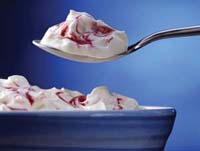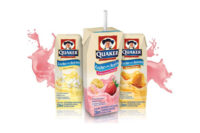
|
During a recent visit to Whole Foods Market, I slowed down my pace in order to better observe the trends in new products and label claims. Filtering out natural, organic and similar marketing tactics, one solid trend that was apparent across most food categories was a tie-in to fruit. The pork chops had a serving suggestion to include apple sauce. Breakfast cereals either contained dried fruit pieces or a recommendation to add something fresh from the farm stand.
What really caught my eye was the new Bolthouse Farms 50/50 Tropical Juice blend, which is half fruit juice and half vegetable juice. Front labels convey that each 32-ounce bottle contains four fruit and four vegetable servings, while side panels get specific, indicating that each bottle contains three oranges, 2/3 of a passion fruit, one guava, 12 1/2 carrots, 2 1/3 pears and 2 3/4 apples. Underneath this is the message that “five fruit and vegetable servings are recommended every day for good health.”
The dairy industry can do this, too. Dairy processors are fortunate, as they start with an inherently nutritious base (milk) that serves as an ideal carrier for fruits. Choosing quality fruit ingredients can “super-fy” your products by further boosting the nutrient profile of milk since ingredients based on whole fruits tend to be void of fat; low in sodium; a source of fiber, vitamins, minerals and antioxidants; and often contain minimal added sugar. In addition, fruit ingredients are a natural source of color, flavor and texture.
The dairy industry can help Americans meet their daily fruit requirements by using high-quality fruit ingredients in product formulations — such as whole cherries in yogurt parfaits, not a syrupy variegate. Use your label to convey fruit inclusion. Add even more value by incorporating super fruits, those that contain exceptionally high levels of antioxidants and phytonutrients associated with health and wellness benefits. And consider lower-sugar fruit ingredients, or those sweetened with a high-intensity sweetener, such as one based on stevia.
According to a recent survey by the Calorie Control Council (CCC), Atlanta, 185 million Americans have been “weight conscious” during the past year and 54% say they are achieving their goals by exercise, cutting back on sugar by using low-calorie or reduced-sugar products, and restricting portion sizes. Consumers also want more bang for their buck and for the calories in the food and beverage choices they make.
“With life busier and more stressful than ever, rather than making a complete overhaul, people will be looking for small steps they can take to be healthier,” says Beth Hubrich, a registered dietitian and executive director of the CCC. “Simple lifestyle changes, such as increasing fruit and veggies by one serving per day can make a big difference in calorie reduction”, she says.
Through innovative combinations of various fruit ingredients, it is pretty easy to deliver a half-serving of fruit through most yogurts and frozen desserts. In some formulations, such as a smoothie or yogurt drink, a full serving is possible. Fruit ingredient options range from concentrated powders and juices to dices and slices. The amount of various fruit ingredients required to meet a fruit serving varies based on the concentration level.
Another Whole Foods Market observation I made was how many superfruits have become mainstream. Pomegranate, acai and blueberry still dominate, but another to take note of, and possibly work into your product development efforts, is mangosteen. Antioxidant-rich mangosteens are a sweet and tangy fruit with a deep purple color. However, the purple pericarp is not edible. Rather, mangosteen ingredients come from the white interior flesh. Juices, concentrates, purees and powders are the most common forms.
Ingredient suppliers are also getting creative with their fruit offerings. For example, fruit clusters are inclusions for ice cream or yogurt that contain a high percentage of fruit agglomerated with nuts, oats, grains, rice crisps or cracker/cookie-type pieces. The possible combinations are endless. The clusters incorporate the natural goodness of fruit and then build on it through the addition of other nutrient-rich ingredients.
Various dried fruits, usually apples and cranberries, now come in a variety of shapes and sizes and can be infused with juice concentrates. For indulgence, they can also be combined with chocolate or a fruity glaze.
The combinations are infinite, with the benefits many. n



